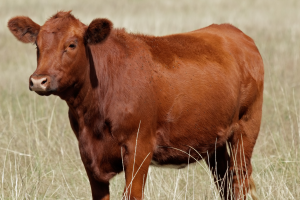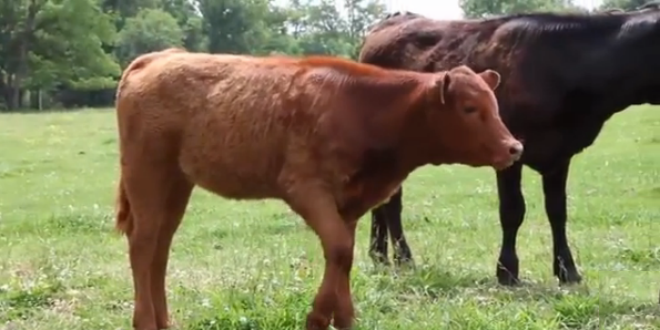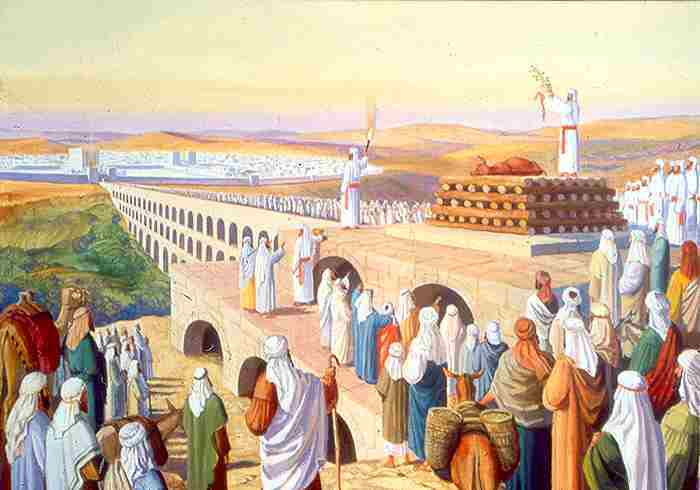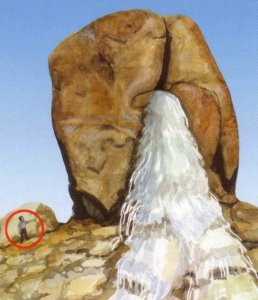חוקת
Parasha Chukat
Bamidbar (Numbers) 19:1-21:35
Shemoth (Exodus) 19:1And YaHuWaH spoke to Mosheh and to Aharon, saying, 2 “This is a law of the Torah which YaHuWaH has commanded, saying, ‘Speak to the children of Yisra’Ãl, that they bring you a red heifer, a perfect one, in which there is no blemish and on which a yoke has never come.3‘And you shall give it to El’azar the priest, and he shall bring it outside the camp, and shall slaughter it before him.4 ‘And El’azar the priest shall take some of its blood with his finger, and sprinkle some of its blood seven times toward the front of the Tent of Meeting.
This week’s Torah Portion is named חוקת Chukat meaning “decrees”. חוקת Chukat are laws and decrees found in Torah that have no rational human logic but can only be understood by the Qodesh One himself. חוקת Chukat begins with the laws regarding Ha’Parah Adumah (The Red Heifer). The sacrifice of the red heifer is a bit perplexing, though comprehensible through the lenses of one who is in tune with Mashyach (Messiah). In this puzzle we see the echoing of the pattern of redemption. For one to overcome death and the uncleanliness involved, the life of the innocent is required. We will examine this subject further. The sacrifice of הפָרָה אֲדֻמָּה Ha’Parah Adumah (The Red Heifer) purifies a person from tum’ah (impurity) that comes about when one contacts a corpse.
הפָרָה אֲדֻמָּה Ha’ Parah Adumah must not contain a defect, this means both no physical defect but further means that the heifer must be truly אֲדֻמָּה Adumah meaning “red”. This meant the heifer must have only red hairs, if a black hair was discovered the heifer was disqualified for sacrifice. Interestingly the word אֲדֻמָּה adumah in the feminine is spelled the same as the word for ground, which is also אֲדֻמָּה adumah. These words come from the word אָדָם Adam which means “man” but is the actual name of the original man created by YaHuWaH in the garden. אָדָם “Adam” also stems from the word דָם “dam” which means blood. Here we see the connection in the specific color of the heifer which is red or אֲדֻמָּה Adumah with blood , man and more specifically the first man. Sovereign Dawid (David) was said to be אַדְמֹונִי Adomni in 1 Samuel 16:12, 1 Samuel 17:42. Sovereign Shlomo (Solomon) the son of Dawid was also described this way in Song of Songs 5:10. אַדְמֹונִי Adomni is often translated ruddy meaning “reddish”. Esaw was called אֱדֹֽום Edom, which meant “red”. The concept of red heifer is attached deeply to the redemption pattern for the sons of Adam. Messiah Yahuwshuwa is a descendant of Dawid and Shlomo, he is the ultimate fulfillment of the prophecy imbedded in הפָרָה אֲדֻמָּה Ha’ Parah Adumah, “The Red Heifer.”
There are many red heifers in the world, hundreds if not even thousands. However finding a red heifer that meets the scriptural requirement is a bit more difficult. The reason it is difficult to find such a heifer in modern times is in the description in the Book of Bamidbar (Numbers), Chapter 19: “This is the ordinance of the law which YaHuWaH hath commanded, saying, Speak unto the children of Israel, that they bring thee a red heifer without spot, wherein is no blemish, and upon which never came yoke.”
Cows that are raised on dairy and meat farms are subjected to all sorts of blemish-causing conditions, such as ear piercing with numbered tag, cuts or bruises from roughhousing with other cows or contact with barbwire fences. If cheap cattle feed is used they can develop ulcers from ingesting metal accidentally mixed in. Even a vaccination could count as a blemish and nearly all small time and commercial farmers vaccinate in the modern world. Most cows on farms are used for work as well, that is forbidden according to the specifics in Torah. Also, the heifer must never have given birth or it is disqualified. Such a heifer must be groomed and planned from birth and taken care of extremely well.
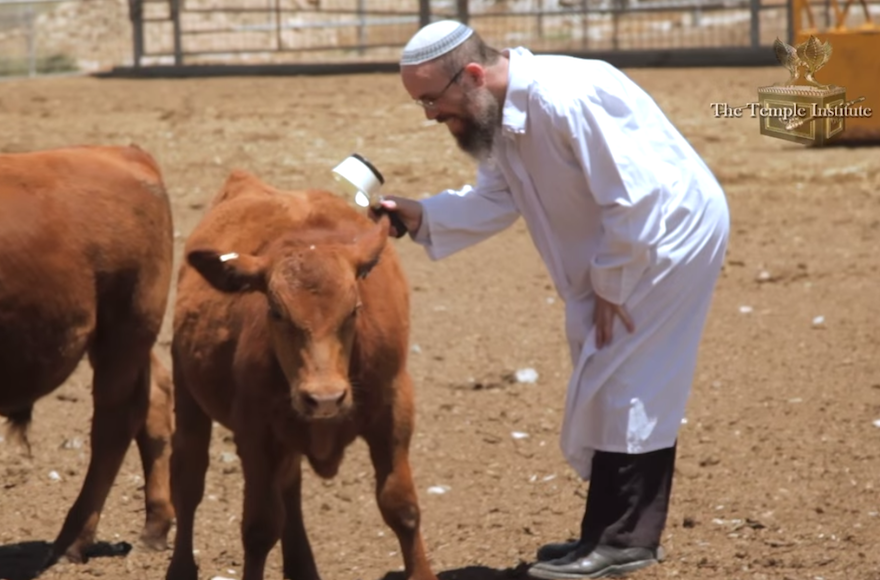
Member of The Temple Institute examines heifer to ensure all hairs are red.
In modern times there exists a movement to rebuild the Temple in Yerushalayim (Jerusalem). The Temple Institute has over 70 vessels and objects ready for the building of the temple and they have started a breeding program for the rare פָרָה אֲדֻמָּה Parah Adumah or Red Heifer. Whether you agree or disagree with this it is an obvious sign of the coming of Messiah Yahuwshuwa.
This offering is first and foremost unique in that it is not sacrificed on the mizbeach (altar) but rather it is taken outside the camp and then slaughtered. During the second temple period, during the time of Yahuwshuwa Ha Mashyach (the messiah) this was performed on the Mount of Olives.
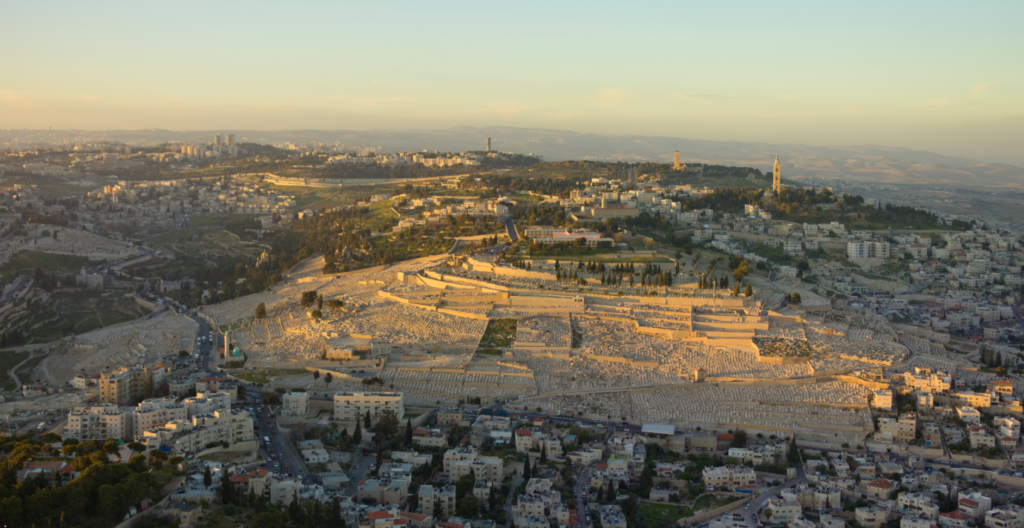
Mount of Olives (Modern Times)
After sprinkling the blood seven times in the direction of the Mishkan (Dwelling Place) aka “Tent of Meeting” the Kohen Ha’Gadol is to burn the entire heifer which includes the skin, flesh, blood and even the dung, together it is burned with a piece of cedar wood, hyssop and a scarlet thread.
It should be noted that cedar wood, hyssop and scarlet are used to cleanse tzara’at (leprosy). The ashes of this offering are collected together for further use. When a man dies in his tent all that go into the tent are tame’ (unclean) for a span of one shabua (week) which is seven days. For the person who becomes tame’ in this way the ashes of the red heifer are placed in a vessel filled with mayim chayim or Living Water. Only one who is Tahor (pure/clean) can sprinkle it upon the impure person on the third and seventh day. On the seventh day he shall wash his clothes and bathe himself in water, and at evening he shall be cleansed. He is cleansed at evening because the evening ends the seventh day period and begins the eighth day. The number seven represents completion, the number eight represents new beginnings. The one who sprinkles the water and anyone who touches the water is unclean until evening. YaHuWaH as an “everlasting decree” describes the command of the ordinance of Parah Adumah, the red heifer. This means that the pattern in eternity for the cleansing of those who have touched death involve all the elements found in this particular offering. Messiah Yahuwshuwa can be seen in all elements of this purification. It is the through the death of the red heifer and the sufferings it goes through that living water can cleanse those who are impure. Messiah Yahuwshuwa told us that if we believe in him out of our inner most being would come forth mayim chayim or “Living Water.”
Mayim Meribah (Waters of Strife)
It came to be after forty long years of journeying the desert that the people arrive in Qadesh (meaning set apart) in the wilderness of Zin. This becomes the resting place of Miriam the sister of Mushah and Aharon. At her death the text reads “and there was no water for the congregation”. Various Yahudi (“Jewish”) commentaries have stated that there was a rock that followed the children of Yashar’al (Yisrael) through the wilderness. The Brit Chadasha (Renewed Covenant) actually states that Yahuwshuwa the Messiah was the rock that followed the congregation. Interestingly enough this is considered scripture by most, myself included though the Torah does not actually say this explicitly. It is said that when Miriam died that in her remembrance the well dried up thus it is written “ and there was no water for the congregation.”
The people began to complain to Mosheh and Aharon saying it was better that they had died with the rebels in the destruction of Qorah and that they had not been brought to a land of figs, vines and pomegranates and that there was no water to quench the thirst of the population of over one million people.
Bamidbar (Numbers) 8And YaHuWaH spoke to Mosheh, saying,8 “Take the rod and assemble the congre- gation, you and your brother Aharon. And you shall speak to the rock before their eyes, and it shall give its water. And you shall bring water for them out of the rock and give drink to the congregation and their livestock.”9 And Mosheh took the rod from before YaHuWaH as He commanded him.10And Mosheh and Aharon assembled the assembly before the rock. And he said to them, “Hear now, you rebels, shall we bring water for you out of this rock?”11 Then Mushah lifted his hand and struck the rock twice with his rod. And much water came out, and the congregation and their livestock drank.12But YaHuWaH spoke to Mosheh and to Aharon, “Because you did not believe Me, to set Me apart in the eyes of the children of Yisra’Ãl, therefore you do not bring this assembly into the land which I have given them.”13These were the waters of Meribah, because the children of Yisra’Ãl contended with YaHuWaH, and He was set apart among them.
Mosheh transgressed against YaHuWaH and was not allowed to enter the Promised Land. This is due to the striking of the rock, when YaHuWaH had said “speak to the rock”, Mushah had previously been commanded years ago to strike the rock, the rock was only to be smitten once and this was the pattern. The reason is that indeed the Messiah is the Rock, in the deepest levels of understanding Torah. Messiah must only be struck once, the second time he is to be spoken to as a living Rock who hears and gives the Mayim Chayim (Living Water). Mushah’s transgression could also involve the way he addressed the people claiming that he and Aharon could bring water from the rock when only YaHuWaH could do so.
After this Mosheh sends messengers to Sovereign of Edom asking to go down the “Sovereigns Highway” only and not passing through fields or vineyards. However Edom refuses and block the passage. From there they journey to Hor HaHar the Mountain upon a Mountain. This is where YaHuWaH takes Aharon and his Son El’azar up the mountain. Here Aharon is told he will not enter the land but die because of his rebellion at the Waters of Meribah (Strife). Upon the mountain Mushah takes the garments of the Kohen HaGadol (High Priest) off Aharon and dresses El’azar with them. Aharon dies here and all the congregation mourned for thirty days.
The Brass Serpent
At this point Kanaanites from Arad siege an attack against the children of Yashar’al. Yashar’al repents and turns to YaHuWaH for his help and the Kanaanites are defeated. The spoils are pledged to the Miqdash (sanctuary).
Bamidbar (Numbers19:4 And they departed from Mount Hor by the Way of the Sea of Reeds, to go around the land of Edom. But the being of the people grew impatient because of the way.5And the people spoke against Elohim and against Mosheh, “Why have you brought us up out of Mitsrayim to die in the wilderness? For there is no food and no water, and our being loathes this light bread.”6 And YaHuWaH sent fiery serpents among the people, and they bit the people. And many of the people of Yashar’al (Yisrael) died.7 Then the people came to Mosheh, and said, “We have sinned, for we have spoken against YaHuWaH and against you. Pray to YaHuWaH to take away the serpents from us.” So Mosheh prayed on behalf of the people.8And YaHuWaH said to Mosheh, “Make a fiery serpent, and set it on a pole. And it shall be that everyone who is bitten, when he looks at it, shall live.”9 So Mosheh made a bronze serpent, and put it on a pole. And it came to be, if a serpent had bitten anyone, when he looked at the bronze serpent, he lived.
YaHuWaH sent among them Nechashim Seraphim. Nachosh is translated serpent and also means “whisperer”. The word Seraphim is used to describe beings who live in the Shamayim who appear as winged, fiery serpents. The serpent has a duality in meaning. In Shamayim (“Heaven”) there are Seraphim and they praise YaHuWaH day and night, however on the earth, the Nachash deceived humanity. The Seraph however is Qodesh (set apart) and they were used to execute judgment. To remedy this judgement, Mosheh is commanded to make a bronze serpent and put it on a pole and those who have been bitten shall look at it and be healed. Yahuwshuwa is the picture of the serpent on the pole. He died on a pole and was lifted up in this way; he refers to this with his own words in the Brit Chadasha (Renewed Covenant). Just as the serpent is despised and rejected because of sin, so Yahuwshuwa was despised and rejected due to the sin of the people.
The Song of the Well
With the Promised Land in scope they stop at Ovot, Iyei Avarim (“Desolate Passes”), the Zered Brook and the far bank of the Arnon River. Then they take up camp at Be’er.
Bamidbar (Numbers) 22:16And from there on to Be’er, which is the well where YaHuWaH said to Mosheh, “Gather the people, and let Me give them water.”17Yisra’el then sang this song: “Spring up, O well! Sing to it,18a well the leaders sank, which the nobles of the people dug with their staves, by the word of the Law-giver.” Then from the wilderness on to Mattanah,19from Mattanah to Na’ali’Ãl, from Na’ali’Ãl to Bamoth,20 and from Bamoth, in the valley that is in the country of Mo’ab, to the top of Pisgah which looks down on the wasteland.
The people of Yisrael now send messengers to Sichon, king of the Emorites, bidding permission to pass through his land. Sichon gathers his armies and attacks. Sichon was a giant, one of the Nephilim, he was said to be a powerful sorcerer and at the age of five hundred. Though we do know he was a Nephil, that means he definitely practiced magic, we do not know his age according to Torah alone. Although these were fallen ones aka nephilim the Emorites were defeated and the people of YaHuWaH occupied their land. Og, king of Bashan, looks for vengeance for the death of his Nephil relative he also gathers his people against the Yisraelites, and then he is defeated and his lands too are occupied. These Kings were hybrids created by the fallen ones when they took women and they bore children. Though these demonic creatures were frightening and powerful, YaHuWaH’s people are giant slayers!
“The children of Yashar’al (Yisrael) journeyed, and they camped in the plains of Moab, across the Yarden (Jorden) from Yericho.’


